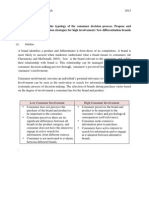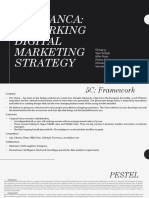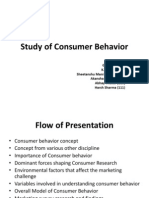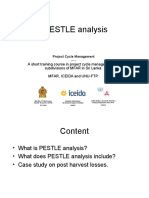Strategic Decision
Strategic Decision
Uploaded by
Ganesh TripathiCopyright:
Available Formats
Strategic Decision
Strategic Decision
Uploaded by
Ganesh TripathiCopyright
Available Formats
Share this document
Did you find this document useful?
Is this content inappropriate?
Copyright:
Available Formats
Strategic Decision
Strategic Decision
Uploaded by
Ganesh TripathiCopyright:
Available Formats
strategic decision
Definition
Chosen alternative that affects key factors which determine the success of an organization's strategy. In comparison, atactical decision affects the day-to-day implementation of steps required to reach the goals of a strategy.
Source: Johnson, G. and Scholes, K. (1997). Exploring Corporate Strategy, Fourth Edition, Prentice Hall, New York.
Characteristics of Strategic Decisions
1. Strategic decisions are likely to affect the long-term direction of an organisation. 2. Strategic decisions are normally about trying to achieve some advantage for the organisation. 3. Strategic decisions are likely to be concerned with the scope of an organisations activities: Does (and should) the organisation concentrate on one area of activity, or does it have many? The issue of scope of activity is fundamental to strategic decisions because it concerns the way in which those responsible for managing the organisation conceive its boundaries. It is to do with what they want the organisation to be like and to be about. 4. Strategy is to do with the matching of the activities of an organisation to the environment in which it operates. 5. Strategy can also be seen as 'stretching' an organisation's resources and competences to create opportunities or capitalise on them. It is not just about countering environmental threats and taking advantage of environmental opportunities; it is also about matching organisational resources to these threats and opportunities. There would be little point in trying to take advantage of some new opportunity if the resources needed were not available or could not be made available, or if the strategy was rooted in an inadequate resource-base. 6. Strategic decisions therefore often have major resource implications for an organisation. In the 1980s a number of UK retail firms had attempted to develop overseas with little success and one of the major reasons was that they had underestimated the extent to which their resource commitments would rise and how the need to control them would take on quite different proportions. Strategies, then, need to be considered not only in terms of the extent to which the existing resource-base of the organisation is suited to the environmental opportunities but also in terms of the extent to which resources can be obtained and controlled to develop a strategy for the future.
7. Strategic decisions are therefore likely to affect operational decisions, to set off waves of lesser decisions. 8. The strategy of an organisation will be affected not only by environmental forces and resource availability, but also by the values and expectations of those who have power in and around the organisation. In some respects, strategy can be thought of as a reflection of the attitudes and beliefs of those who have the most influence on the organisation. Whether a company is expansionist or more concerned with consolidation, and where the boundaries are drawn for a companys activities, may say much about the values and attitudes of those who influence strategy -- the stakeholders of the organisation. The beliefs and values of these stakeholders will have a more or less direct influence on the organisation.
Overall, if a definition of strategy is required, these characteristics can provide a basis for one. Strategy is the direction andscope of an organisation over the long term, which achieves advantage for the organisation through its configuration ofresources within a changing environment, to meet the needs of markets and fulfil stakeholder expectations. Strategic decisions are, then, often complex in nature: it can be argued that what distinguishes strategic management from other aspects of management in an organisation is just this complexity. The complexity arises for at least three reasons. First, strategic decisions usually involve a high degree of uncertainty: they may involve taking decisions on the basis of views about the future which it is impossible for managers to be sure about. Second, strategic decisions are likely to demand an integrated approach to managing the organisation. Unlike functional problems, there is no one area of expertise, or one perspective that can define or resolve the problems. Managers, therefore, have to cross functional and operational boundaries to deal with strategic problems and come to agreements with other managers who, inevitably, have different interests and perhaps different priorities. This problem of integration exists in all management tasks but is particularly problematic for strategic decisions. Third, as has been noted above, strategic decisions are likely to involve major change in organisations. Not only is it problematic to decide upon and plan those changes, it is even more problematic actually to implement them. Strategic management is therefore distinguished by a higher order of complexity than operational tasks.
Strategic Decisions - Definition and Characteristics
inShare1
Strategic decisions are the decisions that are concerned with whole environment in which the firm operates, the entire resources and the people who form the company and the interface between the two.
Characteristics/Features of Strategic Decisions
a. b. c. d. e. Strategic decisions have major resource propositions for an organization. These decisions may be concerned with possessing new resources, organizing others or reallocating others. Strategic decisions deal with harmonizing organizational resource capabilities with the threats and opportunities. Strategic decisions deal with the range of organizational activities. It is all about what they want the organization to be like and to be about. Strategic decisions involve a change of major kind since an organization operates in ever-changing environment. Strategic decisions are complex in nature.
f. g.
Strategic decisions are at the top most level, are uncertain as they deal with the future, and involve a lot of risk. Strategic decisions are different from administrative and operational decisions. Administrative decisions are routine decisions which help or rather facilitate strategic decisions or operational decisions. Operational decisions are technical decisions which help execution of strategic decisions. To reduce cost is a strategic decision which is achieved through operational decision of reducing the number of employees and how we carry out these reductions will be administrative decision.
The differences between Strategic, Administrative and Operational decisions can be summarized as followsStrategic Decisions Administrative Decisions Operational Decisions
Strategic decisions are long-term decisions.
Administrative decisions are taken daily.
Operational decisions are not frequently taken.
These are considered where The future planning is concerned.
These are short-term based Decisions.
These are medium-period based decisions.
Strategic decisions are taken in Accordance with organizational mission and vision.
These are taken according to strategic and operational Decisions.
These are taken in accordance with strategic and administrative decision.
These are related to overall Counter planning of all Organization.
These are related to working of employees in an Organization.
These are related to production.
These deal with organizational Growth.
These are in welfare of employees working in an organization.
These are related to production and factory growth.
You might also like
- Ethics in Practice Hugh Lafollette PDFDocument2 pagesEthics in Practice Hugh Lafollette PDFJose0% (3)
- Wrigley's Eclipse Gum - Case Analysis Report: 1. Key Issues/ProblemsDocument4 pagesWrigley's Eclipse Gum - Case Analysis Report: 1. Key Issues/ProblemsAkaash HegdeNo ratings yet
- MC Donald's - Internal StakeholdersDocument2 pagesMC Donald's - Internal StakeholdersAli ButtNo ratings yet
- Netflix, Inc.-The Mouse Strikes Back SolutionDocument1 pageNetflix, Inc.-The Mouse Strikes Back SolutionArhamNo ratings yet
- The Problem of A Medical RepresentativeDocument2 pagesThe Problem of A Medical RepresentativeUjwal Narasapur0% (1)
- Prashanti Technologies: A Case Analysis On in Partial Fulfilment of Advanced Course in Labour Laws Submitted byDocument5 pagesPrashanti Technologies: A Case Analysis On in Partial Fulfilment of Advanced Course in Labour Laws Submitted byANUSHKA PGPHRM 2020 BatchNo ratings yet
- SalesDocument3 pagesSalesEdgardo MartinezNo ratings yet
- Analysis of Servqual ModelDocument7 pagesAnalysis of Servqual Modelvineet soodNo ratings yet
- Marshall Chapter 3 Case StudyDocument2 pagesMarshall Chapter 3 Case Studyapi-3173686540% (1)
- Hausser Food Products CompanyDocument1 pageHausser Food Products CompanyOlojo Oloyomi MichaelNo ratings yet
- Whirlpool Case StudyDocument17 pagesWhirlpool Case Studyjayant242025% (4)
- Thomas Green L05 Case StudyDocument6 pagesThomas Green L05 Case StudyGreggi RizkyNo ratings yet
- Case StudyDocument5 pagesCase Studyvinaycool12344150No ratings yet
- Primark Case StudyDocument3 pagesPrimark Case StudyMd. Khairul IslamNo ratings yet
- Aleena Amir EM Quiz 7Document3 pagesAleena Amir EM Quiz 7Aleena AmirNo ratings yet
- Case Analysis 6 "Struggling Samsung Electronics": MM 5012 Business Strategy & Enterprise ModellingDocument11 pagesCase Analysis 6 "Struggling Samsung Electronics": MM 5012 Business Strategy & Enterprise ModellingAziz Wimawan KuswanputraNo ratings yet
- Strategic ManagementDocument4 pagesStrategic ManagementA CNo ratings yet
- Social Psychology of BrandsDocument5 pagesSocial Psychology of BrandsAtiqah IsmailNo ratings yet
- PaneraDocument22 pagesPaneraasmshihabNo ratings yet
- Financial Management E BookDocument4 pagesFinancial Management E BookAnshul MishraNo ratings yet
- HW JoseDocument5 pagesHW JoseBarouyr TekianNo ratings yet
- IPL - A Group 9 - FinalDocument8 pagesIPL - A Group 9 - Finalvibhor1990No ratings yet
- Fake Brand AssignmentDocument5 pagesFake Brand AssignmentMeetu RawatNo ratings yet
- 1 If You Were Kelly What Would You Tell TheDocument1 page1 If You Were Kelly What Would You Tell TheAmit Pandey100% (1)
- The Evolution of Lean Six Sigma at 3M, Inc.: Presented By: John WhiteDocument9 pagesThe Evolution of Lean Six Sigma at 3M, Inc.: Presented By: John WhiteTherese Janine HetutuaNo ratings yet
- Compensation Management by Mousumi Sengupta (CM) PDFDocument7 pagesCompensation Management by Mousumi Sengupta (CM) PDFRahul SinghNo ratings yet
- Entreprneurship Case 1.1 and 1.2Document3 pagesEntreprneurship Case 1.1 and 1.2shamim islam limon100% (1)
- The Vanca Group 5Document6 pagesThe Vanca Group 5Vipul Sehgal100% (1)
- Case Study - Can A Work-at-Home Policy Hurt Morale? NoDocument3 pagesCase Study - Can A Work-at-Home Policy Hurt Morale? NoPrashant GautamNo ratings yet
- Whitbread PLC - Case AnalysisDocument2 pagesWhitbread PLC - Case AnalysisUttam100% (1)
- 07 Activity 1 Strategic - ManagementDocument1 page07 Activity 1 Strategic - ManagementLeiann PongosNo ratings yet
- JFC LongverDocument4 pagesJFC LongverKirkNo ratings yet
- Consumer Behavior FinalDocument23 pagesConsumer Behavior FinalHarsh Sharma100% (1)
- Chapter 16 Case Application 1Document4 pagesChapter 16 Case Application 1Thư VõNo ratings yet
- Circuit City Case StudyDocument2 pagesCircuit City Case Studyjannetka1100% (1)
- PPG-Self Directed Workforce Company OverviewDocument3 pagesPPG-Self Directed Workforce Company OverviewKrishNo ratings yet
- Case Study Htf735 (Fruit Smoothie) - 2Document9 pagesCase Study Htf735 (Fruit Smoothie) - 2AfrinaNo ratings yet
- Samsung & IBMDocument3 pagesSamsung & IBMFauzi FauziahNo ratings yet
- Unit 1 Consumer BehaviourDocument16 pagesUnit 1 Consumer BehaviourPriyanka Zalpuri100% (1)
- PESTLEDocument21 pagesPESTLEFarah NawazNo ratings yet
- Session 8Document2 pagesSession 8Yến Vũ KimNo ratings yet
- Sec A Group 9 When A New Manager StumblesDocument13 pagesSec A Group 9 When A New Manager StumblesKpvs NikhilNo ratings yet
- Assignment No 2-BA 939 Strategic ManagementDocument5 pagesAssignment No 2-BA 939 Strategic ManagementGemar EstrellaNo ratings yet
- Assignment MBCDocument1 pageAssignment MBCsarahNo ratings yet
- CSR Master Class Case StudiesDocument18 pagesCSR Master Class Case StudiesSean FlynnNo ratings yet
- Zero WageDocument2 pagesZero WageRubak Bhattacharyya100% (1)
- Assignment On OBDocument24 pagesAssignment On OBHarshit MarooNo ratings yet
- VNFPP LTD Using Holistic Marketing in A Small Enterprise ContextDocument10 pagesVNFPP LTD Using Holistic Marketing in A Small Enterprise ContextSeptian AdiNo ratings yet
- Final-Term AssignmentDocument14 pagesFinal-Term AssignmentZaw Myo HeinNo ratings yet
- Stewardship Models of WilsonDocument3 pagesStewardship Models of WilsonAmar narayanNo ratings yet
- McDonald's SWOT Analysis (2024 Updated)Document19 pagesMcDonald's SWOT Analysis (2024 Updated)Testing KDNo ratings yet
- Whole Food MARKET1Document28 pagesWhole Food MARKET1Keepllng Mananya HrzNo ratings yet
- Final Grp1 Bay MadisonDocument11 pagesFinal Grp1 Bay MadisonDilip Thatti0% (1)
- Perk Priority AnalysisDocument1 pagePerk Priority Analysisshashank_swNo ratings yet
- Value Chain Management Capability A Complete Guide - 2020 EditionFrom EverandValue Chain Management Capability A Complete Guide - 2020 EditionNo ratings yet
- Customers Switching Intentions Behavior in Retail Hypermarket Kingdom of Saudi Arabia: Customers Switching Intentions Behavior in Retail HypermarketFrom EverandCustomers Switching Intentions Behavior in Retail Hypermarket Kingdom of Saudi Arabia: Customers Switching Intentions Behavior in Retail HypermarketNo ratings yet
- New WordDocument6 pagesNew WordAdetunji TaiwoNo ratings yet
- Characteristics of Strategic DecisionsDocument2 pagesCharacteristics of Strategic DecisionsMufaddal Hussain100% (2)
- BBA Strategic Management - IDocument135 pagesBBA Strategic Management - IbijayNo ratings yet
- SHS Subjects Offering 2018 (With Changes in TVL & STEM)Document6 pagesSHS Subjects Offering 2018 (With Changes in TVL & STEM)Ivy Oclaman100% (1)
- Land-Productivity Dynamics in EuropeDocument80 pagesLand-Productivity Dynamics in EuropeIon IonNo ratings yet
- Physical Pharmacy Lecture NotesDocument34 pagesPhysical Pharmacy Lecture NotesNoorul Alam100% (1)
- Carneades' Embassy To RomeDocument203 pagesCarneades' Embassy To Romesextus2014100% (1)
- Possessive Pronouns and Adjectives: RD ND NDDocument4 pagesPossessive Pronouns and Adjectives: RD ND NDmarifeNo ratings yet
- Case Study - Hot Tap, Stopple and By-Pass PDFDocument2 pagesCase Study - Hot Tap, Stopple and By-Pass PDFLuis Durán MirandaNo ratings yet
- Lab 2: Notepad Application: M.Sc. Bui Tan LocDocument8 pagesLab 2: Notepad Application: M.Sc. Bui Tan LocPhat QuyNo ratings yet
- Es855 SH v06 PDFDocument699 pagesEs855 SH v06 PDFmr tuanNo ratings yet
- Facilitating LearningDocument9 pagesFacilitating LearningAngelyn Montibola100% (1)
- Spirited Awayand Japanese CultureDocument21 pagesSpirited Awayand Japanese CultureEireNo ratings yet
- Ethical and Social Responsibilities of The EntrepreneurDocument9 pagesEthical and Social Responsibilities of The Entrepreneurtopherski100% (2)
- CV - Vilma Tafilica 2Document2 pagesCV - Vilma Tafilica 2Vilma TafilicaNo ratings yet
- 670 GestaltLanguageProcessingDocument2 pages670 GestaltLanguageProcessingMuhammad Reza SamimiNo ratings yet
- RF and Antenna BasicsDocument69 pagesRF and Antenna BasicsEduardo Carrasquero50% (2)
- Cambridge O Level: PHYSICS 5054/42Document12 pagesCambridge O Level: PHYSICS 5054/42Manas GiteNo ratings yet
- Presentation - 9971 - Retaining Wall Slide DeckDocument57 pagesPresentation - 9971 - Retaining Wall Slide DeckvethoNo ratings yet
- Solutions Manual Urban Drainage 2ndedDocument17 pagesSolutions Manual Urban Drainage 2ndedJamesBonn OlingaNo ratings yet
- Crossword PuzzleDocument1 pageCrossword Puzzlejoshualohman6No ratings yet
- IncubatoruoDocument9 pagesIncubatoruoPratik PatilNo ratings yet
- 15 Light, Shadows and ImagesDocument2 pages15 Light, Shadows and Imagesshiva karthikNo ratings yet
- Isdn Pocket Guide 1Document37 pagesIsdn Pocket Guide 1api-3722785No ratings yet
- LUSEMs Referencing Guide - 3rd EditionDocument17 pagesLUSEMs Referencing Guide - 3rd Editionwojaxep375No ratings yet
- Configuration Aerodynamics: William H. Mason Virginia Tech Blacksburg, VADocument6 pagesConfiguration Aerodynamics: William H. Mason Virginia Tech Blacksburg, VASebastian Felipe Cano Bernal100% (1)
- Application For AdmissionDocument2 pagesApplication For AdmissionJessy EbitNo ratings yet
- Material Comparisons For Studs Astm and JisDocument3 pagesMaterial Comparisons For Studs Astm and JisguluuNo ratings yet
- PHYSICAL SCIENCE MODULE 3, Quarter 2Document18 pagesPHYSICAL SCIENCE MODULE 3, Quarter 2Kennedy Fieldad Vagay100% (4)
- Photon Prog GuideDocument919 pagesPhoton Prog Guidesantosh_aditya2000100% (1)
- Nationalism and Musical Style in Interwar Yogaku - A ReappraisalDocument46 pagesNationalism and Musical Style in Interwar Yogaku - A ReappraisalMert AltuntaşNo ratings yet
- Companies in NOIDADocument8 pagesCompanies in NOIDAarbaz khanNo ratings yet

























































































